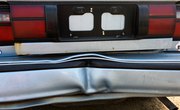No matter what your insurance requirements, you need to understand deductibles and how they can impact both your financial responsibility and your monthly premiums. Generally speaking, the higher you can raise your deductible, the lower your monthly premiums can be.
Actual Damages
When the insurance company determines how much the claim will pay, the company looks at the actual damages to your vehicle or your property. If you have an insurance policy with a $1,000 deductible that means you pay the first $1,000 and the insurance company pays the rest. So if the tree in your front yard falls through your roof during a storm and does $5,000 worth of damage, you pay the first $1,000 and the insurance company pays $4,000 to cover the repairs.
Small Claims
If the damages are less than your $1,000 deductible, you might want to fix them yourself rather than filing a claim. Filing a claim with your insurance company can make you a bigger risk in the company's eyes, and that could mean higher premiums at your next renewal. By fixing small problems yourself you can avoid premium hikes and claim hassles.
Lower Premiums
One benefit of taking the $1,000 deductible option is that it should help lower your premiums. Insurance premiums and deductibles move in opposite directions, and the higher your deductible the lower your premiums should be. If you are taking out a new car or homeowners insurance policy, price the premiums for each deductible level. That way you can see how the deductible affects your premium and make the decision that gives you the most savings.
Proper Budgeting
If you are able to budget properly, opting for a $1,000 deductible instead of a $250 or $500 one can actually save you money. The key is to calculate the premium savings that deductible change generates, and then put those savings directly into a special savings or money market account. Using a money market account or savings account with a high rate of interest can maximize your money and make it easier to pay the higher costs if you do have an accident or suffer a loss. If you drive accident free, or do not have a homeowners insurance claim, the money in that account can keep growing month after month. Keep contributing to this special fund even after the $1,000 threshold has been reached, since you can then use the funds for other purposes, like the down payment on a new car.
References
- Pueblo.gov: 12 Ways to Save on Homeowners Insurance
- State of Washington: How Car Insurers Set Their Rates
- Insurance Information Institute. "How to Save Money on Your Homeowners Insurance." Accessed April 1, 2020.
- Insurance Information Institute. "9 Ways to Lower Your Auto Insurance Costs." Accessed April 1, 2020.
- Insurance Information Institute. "12 Ways to Lower Your Homeowners Insurance Costs." Accessed April 1, 2020.
Writer Bio
Based in Pennsylvania, Bonnie Conrad has been working as a professional freelance writer since 2003. Her work can be seen on Credit Factor, Constant Content and a number of other websites. Conrad also works full-time as a computer technician and loves to write about a number of technician topics. She studied computer technology and business administration at Harrisburg Area Community College.

